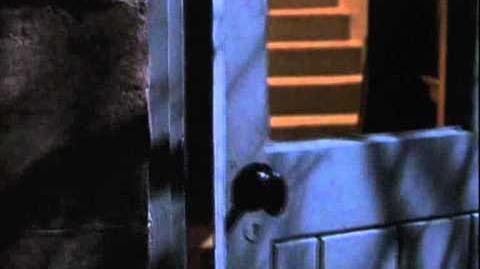- "Imagine that Voldemort's powerful now. You don't know who his supporters are, you don't know who's working for him and who isn't; you know he can control people so that they do terrible things without being able to stop themselves. You're scared for yourself, and your family, and your friends. Every week, news comes of more deaths, more disappearances, more torturing... The Ministry of Magic's in disarray, they don't know what to do, they're trying to keep everything hidden from the Muggles, but meanwhile, Muggles are dying too. Terror everywhere... panic... confusion... that's how it used to be."
- — The uncertainty of the first war[src]
The First Wizarding War[1] was a major wizarding conflict, with foundations as early as the 1940s, but officially beginning in 1970 and ending in 1981. It marked the original "reign" of the most powerful Dark wizard of all time, Lord Voldemort. This war took place at the height of his power and caused widespread panic and fear among the magical and Muggle communities.
The Dark Lord's insurgency was supported by his Death Eaters, a covert and violent group of dark wizards and dark witches who served him and brought terror to both the Muggle and Wizarding Worlds. They were opposed in turn by the British Ministry of Magic and the Order of the Phoenix, an equally secretive organisation founded and led by Albus Dumbledore, which would play a crucial role in both of Voldemort's defeats.
Voldemort's first defeat took place on Hallowe'en 1981 at the hands of an infant Harry Potter. This led to Harry being known as "The Boy Who Lived". Shortly thereafter, all of his remaining Death Eaters were imprisoned, killed, or acquitted, bringing the war to an end, though it would leave permanent scars on the Wizarding World.
History
Prelude
Birth of Lord Voldemort
- "Marvolo, his son, Morfin, and his daughter, Merope, were the last of the Gaunts, a very ancient wizarding family noted for a vein of instability and violence that flourished through the generations due to their habit of marrying their own cousins."
- — Voldemort's unstable ancestry, the House of Gaunt[src]
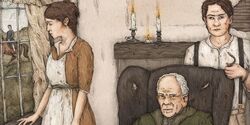
The First Wizarding War had its roots secretly planted when Tom Marvolo Riddle was born on 31 December 1926 to Tom Riddle Senior, a wealthy Muggle aristocrat whose family was the locally unpopular gentry within the village of Little Hangleton, England, Great Britain, and Merope Gaunt, a pure-blood vagabond witch born into the antisocially dysfunctional and heavily inbred supremacist House of Gaunt, who lived in poverty across the valley from the village. Having eloped with Riddle Snr, while the latter was secretly influenced by a Love Potion, the couple caused a great scandal among the villagers over the common unpopularity (although for differing reasons) of the two families. But Merope grew tired of living such a lie when pregnant three months later, and thus lifted the bewitchment on her husband in hopes that he would either return her feelings or stay for their child's sake.
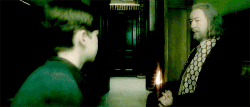
Instead, Riddle Snr fled back to Little Hangleton in utter disgust, leaving his wife in a state of depression in which she gave up the use of magic. Spending the rest of her life as a pauper on the streets of London, England, Merope sold a few stolen Gaunt heirlooms, and died in childbirth while sheltered in the Muggle-run Wool's Orphanage, unable to summon the strength to prolong her life, even for her son's sake. As a result, the orphaned Riddle was left to spend the first eleven years of his life in said orphanage. The coercive circumstances of his conception and extreme lack of parental love likely contributed to his many early warning signs of juvenile delinquency.
During this time, the secret wizarding world to which Riddle unknowingly belonged to developed new levels of anti-Muggle sentiment and economic growth. At some point before his birth, for instance, the notorious and radical Dark wizard Gellert Grindelwald began launching his own magical supremacist revolution on the European mainland and indeed, across the entire wizarding world, fuelled by his quest to obtain all three of the fabled Deathly Hallows and his desire to expose the Wizarding World's corrupt and unethical laws and establishments. With his army of followers and one of the Hallows, the Elder Wand (which he stole from celebrated wandmaker Mykew Gregorovitch), in his possession, Grindelwald aimed to abolish the International Statute of Wizarding Secrecy and subjugate Muggles under a new world order run by wizards, banking on the growth in fear and distrust for the non-magical people to grow his force until his defeat in 1945. Around the same time, cosmetic potioneer Fleamont Potter developed the wizarding beauty product Sleekeazy's Hair Potion, the sales of which quadrupled his family gold. He retired with his wife Euphemia a few years later but sold his company at a vast profit.
Between January and March of 1927, Magizoologist Newton "Newt" Scamander had his bestselling book Fantastic Beasts and Where to Find Them published by Obscurus Books. Having faced Grindelwald thrice, and even aided in his first capture and loss in the election for Supreme Mugwump in 1932, Newt became a nationwide celebrity, and was known for having an integral part in the resistance and eventual defeat of the dark wizard and his acolytes. In the 1930s, magical historian Cantankerus Nott was suspected to have anonymously published the Pure-Blood Directory, which listed the 28 remaining famous pure-blood families in Great Britain, including the House of Black, Lestrange family, the Averys, and Riddle's own family: the Gaunts. Many (but not all) of these families considered themselves superior due to their blood status and looked down on "blood traitors" that supposedly betrayed their proud wizarding lineage by associating with Muggle-borns, who were referred to by many supremacists by the derogative title of "Mudbloods". Some pure-blood families were not included, such as the Potter family, despite the Potters' high status in the wizarding community and influential background.
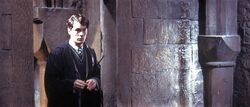
Riddle was finally brought into the wizarding world in 1938, by Professor Albus Dumbledore, at the time the renowned Transfiguration teacher and Deputy Headmaster at Hogwarts School of Witchcraft and Wizardry, who noticed not only the boy's unusually strong and well-developed natural power, but his secretiveness, vindictiveness and will to dominate as well. Despite being concerned about his propensity for malignance, Dumbledore otherwise was impressed with Tom, considering him to be a misunderstood young prodigy. Even Tom Riddle's ability to speak Parseltongue, a power that was closely associated with the dark arts, was of no great concern to Dumbledore, as, Parseltongue or not, the path all comes down to the individual. With a little financial aid from the school, Tom Riddle began attending Hogwarts later that year and was sorted into Slytherin House instantly, where he, unsurprisingly, quickly proved to be an exceptionally gifted student, with Dumbledore himself stating that Tom was the most brilliant and talented student to ever attend the school.
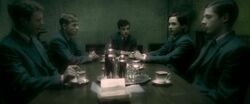
Although his unhealthy mental state secretly worsened as he began his quest for magical power and social domination, he simultaneously got better at concealing his nature and used his good looks and charm to ingratiate himself with his teachers (with the notable exception of Dumbledore) and classmates. Many of them were instantly taken in by his charisma, and by the start of his second year, Riddle was made leader of a like-minded gang of Slytherin students (including Avery and Lestrange).[2] The members of this gang, who all came from wealthy pure-blood families, several of whom were included in the Sacred Twenty-Eight, were involved in a number of nasty incidents during their school years, though Riddle was careful to never become implicated in any wrongdoing or leave any links between them and his band, and was held as a model student, particularly by Professor Horace Slughorn, the Potions Master.
Over time, Riddle grew obsessed with discovering his magical ancestry. He came to the conclusion that his father must have been a wizard because his mother suffered death, a mysterious and terrifying fate that secretly was Riddle's greatest fear above anything; which he foolishly assumed powerful witches and wizards could avoid. When he could find no trace of any Riddles with magical blood, he was forced to accept that his father was a "filthy Muggle" and that the magically powerful could indeed, die. Enraged by this discovery, he forsook his given name and rearranged the letters to create a new title: "Tom Marvolo Riddle" became "I Am Lord Voldemort", and he even began going by Lord Voldemort while still a student, though only with his closest 'friends'.
The Heir of Slytherin
- "You see? It was a name I was already using at Hogwarts, to my most intimate friends only, of course. You think I was going to use my filthy Muggle father's name forever? I, in whose veins runs the blood of Salazar Slytherin himself, through my mother's side? I, keep the name of a foul, common Muggle, who abandoned me even before I was born, just because he found out his wife was a witch? No, Harry — I fashioned myself a new name, a name I knew wizards everywhere would one day fear to speak, when I had become the greatest sorcerer in the world!"
- — Tom Riddle's soul revealing his identity as Lord Voldemort to Harry Potter in the Chamber of Secrets[src]
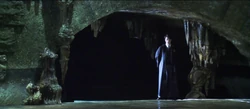
Riddle finally found his magical ancestry in his fourth year, when he used his middle name Marvolo (derived from his maternal grandfather Marvolo Gaunt) to discover the Gaunts and their descent from the Slytherin family. This explained that his exceptionally rare ability to speak Parseltongue made him the "Heir of Slytherin", rumoured in Hogwarts History to be the sole person who could open the legendary Chamber of Secrets constructed by his ancestor to house the means to purge to school within of all that the founder of Slytherin considered unworthy of learning magic, namely Muggle-borns, who Salazar Slytherin had long mistrusted due to the understandable fear that developed from the witch-hunts that were being carried out at the time of Hogwarts's construction.
By opening the Chamber entrance built long ago by a previous Gaunt, Riddle's ancestry would be undeniable and thus, though Tom continued to pursue other ambitions, his most burning obsession at the time remained the Chamber itself, the hidden entrance of which he spent the majority of his fifth year searching for despite most people insisting it was nothing but a myth. Finally, near the end of the year, he succeeded where countless others had failed, by discovering the entrance in a girl's bathroom, which led down into the sewers beneath Hogwarts Lake. Entering the chamber, Riddle encountered the millennium-old Basilisk living inside and by suborning her to his will, he confirmed his connection to the historical dark wizard who bred her: Salazar Slytherin.
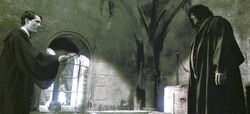
On 13 June 1943, Riddle unleashed the beast into Hogwarts to continue Slytherin's "noble work" of purging the school of Muggle-born students. Several students were petrified and one Muggle-born belonging to Ravenclaw named Myrtle Warren was killed, becoming Riddle's first murder victim. However, this prompted Headmaster Armando Dippet and the Hogwarts Board of Governors to discuss closing the school in the interest of student safety. Faced with returning to the Muggle orphanage he so secretly despised, Riddle abandoned the Chamber of Secrets, sealed the Serpent within until the time was right for her to once again be unleashed and secretly framed half-giant third year Gryffindor student Rubeus Hagrid and his illegal pet acromantula Aragog for the crimes.
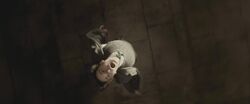
As a result, Hagrid was expelled but offered to be trained as the school's Groundskeeper at Dumbledore's request, whereas Riddle was unjustly rewarded the Special Award for Services to the School by Dippet. With his fear of death exacerbated by having stared it in the face, he used the murder of Myrtle to turn his school diary into his first Horcrux, the method to create which he feverishly researched in the Hogwarts Library's Restricted Section and learned from a copy of Secrets of the Darkest Art that was held there; in addition to further valuable information that he secretly charmed out of Professor Slughorn. Not only would the diary act as Riddle's safeguard against death, but its creator would later on realise that the book could be a potential weapon in the foreseeable future, as Riddle had apparently realised that the fragment of his soul sealed within the diary could possess others and thus be used to open the Chamber of Secrets once again after Riddle was gone from the school.[3]
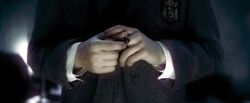
Around August 1943, Riddle tracked down his Gaunt relatives to Little Hangleton, where he found his drunken maternal uncle Morfin Gaunt living in squalor, a far cry from the glorious imaginings that he had had in mind. Regardless, after his nephew confirmed his identity as a fellow Parselmouth, Morfin gave him a biased account of his father leaving his mother to die and abandoning him to the orphanage. In a desire for revenge on the man who had abandoned his mother and him, he entered the Riddle House and used the Killing Curse to kill his father, Tom Riddle Snr, alongside his Muggle grandparents, Thomas and Mary Riddle, then framed Gaunt for the crimes by placing him under the influence of a false memory spell in revenge for the abuse Merope had suffered at Riddle's uncle and grandfather's hands.
As a result, Gaunt boastfully confessed to killing his own in-laws and was sentenced to life imprisonment in the Dementor-infested wizard prison Azkaban (whereas the Riddles' caretaker Frank Bryce was suspected, though not prosecuted, of the murders within the Muggle community), while Riddle stole the Gaunts' signet ring (which, unbeknownst to anyone at the time, including Riddle, contained another of the Deathly Hallows, the Resurrection Stone) and started wearing it as a trophy.
Shortly afterwards, Riddle returned to Hogwarts for his sixth year and discussed the theoretical possibility of creating six Horcruxes (thus splitting the soul into seven pieces) with Professor Horace Slughorn, the Potions Master and his Head of Slytherin House, who was taken aback by Riddle's extreme interest in such powerful and horrific Dark Magic. Although reluctant at first, Slughorn nonetheless gave him an overview of such an experiment with the promise of keeping their discussion between only them. It was revealed to Riddle by Slughorn that Horcruxes were objects that a wizard could place part of their soul into, in order to become immortal and avoid death; though Slughorn warned that in order to split one's soul they must commit murder: killing rips the spirit apart and is a violation against the laws of nature itself. When Riddle mentioned the possibility of creating six Horcruxes, Slughorn was deeply and mortified by the idea of killing even one person for such a ghastly purpose. This apparently gave Riddle what he wanted to hear, and he used the murder of his own father to turn the ring into his second Horcrux.[4]
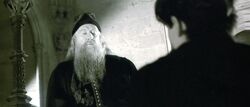
In 1945, Dumbledore, the only person who could see through Riddle's facade, resorted to keeping a close eye on Riddle. In addition, that same year, Dumbledore demonstrated his own legendary magical skill by personally defeating Gellert Grindelwald in a duel, after the international authorities implored him to help end Grindelwald's reign of terror. Following Grindelwald's defeat, Dumbledore obtained ownership of the Elder Wand. Grindelwald was imprisoned for life in his own prison Nurmengard in Austria, his army was destroyed, the Global Wizarding War ended, and peace was restored to the wizarding communities of continental Europe. Dumbledore became an international celebrity and even Tom Riddle showed a reluctant respect towards the elder wizard. Around this time, Riddle also graduated from Hogwarts and quickly applied for the position of Defence Against the Dark Arts teacher, which had just been vacated by the retirement of Galatea Merrythought.
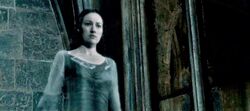
Dumbledore, now a world-famous household name, argued against having him on the staff, warning Armando Dippet of Riddle's untrustworthiness, so Dippet ended up cordially rejecting Riddle on the basis of being too young, though encouraged him to reapply for the position in a few years. Riddle meanwhile began developing an interest in the relics of the Hogwarts founders, and before leaving the school, he charmed the Grey Lady, secretly Helena Ravenclaw; the ghost of Ravenclaw House who was the daughter of Rowena Ravenclaw, to reveal where she had hidden her mother's famous diadem: in a remote forest in Albania. So, he travelled there and retrieved it from a hollow tree, using the murder of an Albanian peasant he encountered along the way and brutally killed, in order to turn the diadem into his third Horcrux. This information would later come to be known to Helena Ravenclaw, who's ghost would, many years later, declare her former friend Riddle to have "defiled" her mother's artefact with his dark magic.[5]
When he returned to England, Riddle was offered several positions in the British Ministry of Magic, but turned them all down and began working at Borgin and Burkes, a dirty and disreputable Dark Arts shop in Knockturn Alley, at the time run by Caractacus Burke, which many believed was a waste of his talents. Tasked with smooth-talking people into parting with their possessions for far less than the actual cost, he used his position to instead secretly learn more about the Dark Arts and ended up forming a one-sided fake friendship with Hepzibah Smith, a wealthy old antiques collector and descendant of Helga Hufflepuff, who fell for his charms.

At some point between 1955 and 1961[6], Riddle visited her to negotiate the sale of a goblin-made suit of armour in her possession, which Hepzibah used as an opportunity to show him two of her most prized treasures: Helga Hufflepuff's cup and Salazar Slytherin's locket, the latter of which Riddle's mother sold to Burke after stealing it from the Gaunts years earlier. In a desire for more selfish gain, he used a little known poison to secretly kill Hepzibah two days later, then framed her house-elf Hokey, for the crime by placing her under the influence of another False Memory Charm. As a result, Hokey was convicted of accidental manslaughter, while Riddle resigned his post at Borgin And Burkes and disappeared without a trace, eventually using the murders of Hepzibah and a Muggle tramp whom he encountered in London, England; to turn the cup and locket into his fourth and fifth Horcruxes respectively.[7]
Immersion in the Dark Arts
Now going exclusively by his preferred name "Lord Voldemort", Riddle laid low and travelled around Europe and Asia. Little is known of his activities during this period, though he explored the Dark Arts extensively, studying the most obscure and arcane branches of magic and consorting with an array of dark wizards, who would all turn out to become his followers in the years to come. As a result of unnamed “magical experiments and transformations”, as well as the creation of his Horcruxes, Voldemort underwent several physical and mental changes, which made him more powerful but less human, and was occasionally accompanied by a group of followers he came to call his "Death Eaters".
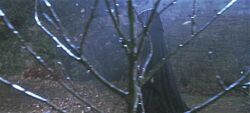
By the time he was a full-fledged adult, around 1968, Riddle donned a hooded cloak (though he physically still did not resemble the monstrous creature he would later in his life) which concealed him completely and he began plotting a wizarding coup, claiming that he was greatly dissatisfied with the current state of the Wizarding World and that he would succeed where so many, including Gellert Grindelwald and Salazar Slytherin, had failed. Voldemort convinced his underlings that to truly create a world full of peace and power, the old regime needed to be torn down at any and all costs and only those who shared pure blood, will and idealism would be allowed to live and thrive in it. In truth however, Lord Voldemort had little interest in political idealism himself. He was completely devoted to amassing his own magical power, and in becoming the most powerful and skilled wizard to have ever lived, invincible and eternal.
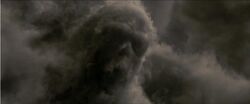
Voldemort devised a personal sigil, one of a serpent protruding from the mouth of a human skull, which he called the Dark Mark, and that he magically branded onto the forearms of his followers as a tattoo, enabling him to summon them to his side at any moment of his choosing. They then began establishing relations with various kinds of dark creatures, including Giants and Werewolves, who had long been shunned by wizardkind. Though the Death Eaters were generally even less tolerant of them than wizarding society in general, these creatures were receptive of their violent and destructive goals. Dark activity suddenly arose throughout Great Britain, a country that had been totally untouched by dark magic; even during the reign of terror of Gellert Grindelwald; and Voldemort began surreptitiously killing poor and homeless Muggles (whose absences would not be noticed) with his followers so that he could reanimate their corpses with Necromancy until he had created an army of Inferi, a feat no other dark wizard in history had ever done.
In the wider British wizarding world, the early actions of the Death Eaters were almost totally unknown, and the 1960s were a time when the tide of social progress clashed with the entrenched social order. At some point around 1960, Scottish Magical Sports and Games advocate Magnus "Dent Head" MacDonald spearheaded a campaign against the Ministry's ban on the dangerous sport Creaothceann, which was enacted in 1762. Unfortunately, he was unsuccessful since the Ministry refused to lift it. In 1962, Minister for Magic Ignatius Tuft was forced out of office for promising to institute a controversial Dementor breeding programme for Azkaban. He was replaced by Nobby Leach, who became the first Muggle-born ever to hold the Minister position, leading senior members of the Wizengamot to resign in protest. In 1963, Muggle expert Mordicus Egg published The Philosophy of the Mundane: Why the Muggles Prefer Not to Know, which posited actual theories about why Muggles continued to be unaware of magic. This was a different take on the subject, as it did not assume Muggles to be stupid nor ignorant.[8]
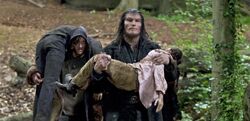
In March 1965, the infamous and sadistic werewolf/wizard Fenrir Greyback killed two Muggle children, avoided prosecution, and even injured the son of a high-ranking Ministry official. This led the Department for the Regulation and Control of Magical Creatures to send one of their best employees', Lyall Lupin; to declare that werewolves were "soulless, evil, and deserving nothing but death", leading to Greyback personally attacking and infecting Lupin's 5-year-old son, Remus Lupin, with Lycanthropy. Lupin and his Muggle wife, Hope Howell, feared Remus's inability to attend Hogwarts in such condition and tried to home-school him.[9] At the same time, the Ministry enacted a ban on the experimental breeding of dark or dangerous creatures, which was supported by Newt Scamander.
Between 1965 and 1971,[10] Dumbledore, who was noted as a social progressive believing strongly in the rights of Muggles as well as Muggle-borns and other oppressed minorities, ascended to the post of Headmaster of Hogwarts. Because of his fame over having defeated Grindelwald, among other accomplishments, Dumbledore was also appointed as Supreme Mugwump of the International Confederation of Wizards [ICW] and Chief Warlock of the Wizenagamot. In these positions of great and influential power, Dumbledore passed extreme legislation to prevent any possible dark forces from threatening overall security around Great Britain while refusing the position of Minister for Magic, claiming it would have given him far too much power, which would be corrupting even to a pure spirit. It was these laws and measures that openly and secretly prevented Voldemort and his Death Eaters from initiating their revolution right away; something that only fuelled Voldemort's hatred of Dumbledore in the years to come.
Voldemort then returned to Hogwarts to reapply for the position of Defence Against the Dark Arts teacher; only this time, he was secretly annoyed to find out that Dumbledore had succeeded Armando Dippet as Headmaster. Unlike the last time he applied for a teaching position, Dumbledore suspected that this desire to teach was insincere, and his main goal was to recruit students to his cause and train them in the dark art. in truth however, Voldemort was hoping to search the school for artefacts like the sword of Godric Gryffindor and turn it into his sixth Horcrux, which would complete his goal of splitting his soul into seven pieces. Unsurprisingly, Dumbledore declined to hire him; telling Riddle that he knew full well that his desire for the position was insincere and that it belied more nefarious desires.

Perhaps out of spite for the Headmaster, or perhaps for being denied a genuine desire to teach Defence Against the Dark Arts, Voldemort secretly placed an unknown dark jinx on the position, making it so a professor could not hold it for more than one school year.[4] Whatever the reason, this ended up having insidious benefits to his long-term plans, as decades of students (including many of his future enemies) would be stuck with erratic, poor-quality knowledge of Defence Against the Dark Arts. While in the school, Voldemort also took the opportunity to conceal Ravenclaw's diadem in the legendary Room of Requirement, foolishly thinking that it was inaccessible to anyone else but himself. He was also unsuccessful in finding Gryffindor's sword.
In 1968, Nobby Leach left office for mysterious health reasons, leading to a conspiracy theory that he had been poisoned by his Muggle-prejudice advisor Abraxas Malfoy.[11] He was then replaced as Minister for Magic by Eugenia Jenkins, who, like her predecessor, was sympathetic to issues of social justice. Squibs then began marching for their rights, which spurred pure-blood supremacists to riot. Throughout the decade, with various minority groups demanding to be treated as equals, many of the old, elite pure-blood houses, to which a plentiful number of the earliest Death Eaters belonged, increasingly felt that their very way of life was being threatened.[12] Many pure-blood supremacists who did not join the ranks of the Death Eaters nonetheless gave their wholehearted support to Voldemort's cause in secret even still.
Open warfare
Dark rebellion
- "...this wizard, about twenty years ago now, started lookin' fer followers. Got 'em, too — some were afraid, some just wanted a bit o' his power, 'cause he was gettin' himself power, all right. Dark days, Harry. "
- — Rubeus Hagrid talking about Voldemort's first rise to power[src]
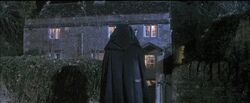
It was in this charged climate that in 1970, Voldemort revealed himself openly, proclaiming himself the Dark Lord, and started to commit extreme acts of terrorism in Britain. With his army of dark wizards and dark creatures at his command, Voldemort launched an assault against the British Ministry of Magic with the intention of toppling it and creating a new world order run by pure-bloods, with Muggle-borns either killed en masse or kept in utter bondage, and Lord Voldemort himself as an immortal leader, though likely ruling from behind the scenes. To achieve these ends, the Death Eaters and their allies (including the particularly destructive Giants, who services Voldemort often used whenever he and his followers wished to go for the grand effect and were responsible for some of the worst atrocities against the non-magical) began openly carrying out attacks on Muggles for sport and to sow chaos.
Cleaning up these attacks, healing survivors, modifying memories, searching for the perpetrators, and attempting to prevent future attacks occupied more and more of the Ministry's time and attention. As their confidence grew, the Death Eaters began _targeting Muggle-born and blood traitor witches and wizards as well, torturing and sometimes killing their victims, which shocked wizarding society. Other "inferior" magical beings such as house-elves (who were treated like vermin) and Goblins (a family of which was slaughtered by Voldemort personally) also suffered under their reign of terror, albeit for different reasons. With terror spreading, certain wizards and witches that committed alleged "blood treachery" by marrying members of the Muggle community were forced to leave their families in the non-magical world in desperate and courageous attempts to protect these loved ones from repercussions by the Dark Lord. Among the individuals who made such a choice was the father of future Hogwarts student Dean Thomas. Having never told his Muggle spouse about the magical world, Mr Thomas abandoned his wife in an effort to protect her and their infant son but was murdered soon after his departure for refusing to pledge allegiance to Voldemort, leaving his partner and son with only their suspicions after the latter manifested as a wizard.
To inspire yet more terror, the Death Eaters would cast the Dark Mark in the sky over every house or scene that they killed at. Though they did not openly join the Death Eaters, many pure-blood supremacists, whose fear of their way of life ending had already been blossoming with the election of a Muggle-born Minister for Magic, gave Voldemort's uprising and the Death Eaters ideals of a new world order centred around the purity of magical blood their full support. Among these supporters were Walburga and Orion Black, whose very marriage was an example of their family's fanatical maintenance of their so-called 'pure-blood', which had left them being forced to marry second cousins. As the war progressed and Voldemort's true colours were shown, however, even wizards of the most active anti-Muggle sentiment were appalled by the actions being taken out on the non-magical community, which eventually came to a point that was regarded as going too far even by the standard of the Blacks, causing Walburga and Orion to 'get cold feet' and withdraw their support.
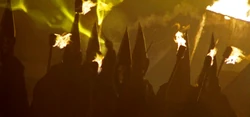
Many Death Eaters also managed to secretly gain strategic positions within the Ministry of Magic itself. They then used blackmail and the Imperius Curse to expand their influence and destabilise the government from within, which was desperately trying to keep order and continue to maintain secrecy from the Muggle world. Augustus Rookwood, an Unspeakable in the Department of Mysteries, managed to set up a particularly successful secret network of espionage within the Ministry.
Fenrir Greyback, who had allied with Voldemort due to the promise of victims, was used frequently by the Death Eaters to force the co-operation of many, threatening otherwise to unleash Greyback on the individuals' children if they did not comply. Minister Jenkins was ill-prepared to lead during wartime, and it seemed that the Ministry was incapable of gaining the upper hand. Voldemort himself personally killed hundreds of wizards, though he tended to only fight those he considered worthy of his attention or too powerful for his followers to defeat. In these encounters, he displayed his extraordinary abilities, many of which were thought impossible, and he very quickly earned the reputation of the most powerful and dangerous dark wizard of all time, surpassing even Gellert Grindelwald.
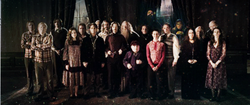
In response to the growing threat of Lord Voldemort and his minions, Albus Dumbledore formed the Order of the Phoenix in 1971; to take the fight directly to the Death Eaters. Though the Ministry officially viewed the Order as a renegade outfit, a number of powerful Ministry officials (such as Elphias Doge and Dedalus Diggle; and the famous Aurors Alastor Moody and Frank and Alice Longbottom) joined instantly to participate in more secretive, sudden assaults to crush the dark rebellion.[13]
When Dumbledore helped black market trader Mundungus Fletcher out of trouble, he joined the Order and, due to his extensive knowledge of the criminal underworld, proved very useful. To allow members of the Order to covertly communicate with each other, Dumbledore invented a method of sending messages via the Patronus Charm.
Height of the war
- Harry Potter: "How d'you know what his plans are?"
- Remus Lupin: "Dumbledore's got a shrewd idea, and Dumbledore's shrewd ideas normally turn out to be accurate."
- Harry Potter: "So what does Dumbledore reckon he's planning?"
- Sirius Black: "Well, firstly, he wants to build up his army again. In the old days he had huge numbers at his command; witches and wizards he'd bullied or bewitched into following him, his faithful Death Eaters, a great variety of Dark creatures. You heard him planning to recruit the giants; well, they'll be just one group he's after. He's certainly not going to try and take on the Ministry of Magic with only a dozen Death Eaters."
- — Harry Potter, Remus Lupin and Sirius Black discussing Voldemort's plans to take over the wizarding world in 1995, by referencing his first attempts[src]
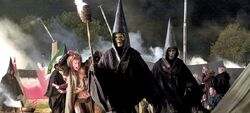
Despite the Order's best efforts, Voldemort continued to grow in magical power and influence, and his attacks, whether carried out personally or by his Death Eaters, became more frequent and brutal. It was clear that Dumbledore was the only wizard in the world who rivalled Voldemort in ability and as a result, Hogwarts became something of a single island of safety in a sea of chaos, the fear of Dumbledore causing Voldemort to never dare attack the school. The nascent Order of the Phoenix initially had very little success, and many continued to be killed by Voldemort. Terror and chaos gripped the populace of wizarding Britain to the point that many began to fear to speak Voldemort's name. He became widely referred to as "He Who Must Not Be Named", or, less formally, "You Know Who" within the first year of his reign.
Numerous ordinary witches and wizards (such as Mr Thomas and Robert McGonagall Jnr) lost their lives for refusing to join the Dark Lord or even accidental involvement in the crossfire, and the Death Eaters frequently cast the Dark Mark over the scenes of their murders. To protect the organisation, Voldemort ensured that Death Eaters did not know the identities of too many of their fellows, and, to society at large, their identities were completely unknown.[14] Increasing the confusion and paranoia even further, Voldemort placed many dozens of innocent victims under the Imperius Curse simultaneously and forced them to carry out his orders and several of his followers, including Mulciber, became specialists in this area. Even friends and family members were not above suspicion of one another.
In 1975, Eugenia Jenkins was ousted as Minister for Magic and replaced by Harold Minchum, a hardliner who placed more Dementors around Azkaban.[12] In addition, ruthless Council of Magical Law Head Judge Bartemius "Barty" Crouch Senior rose rapidly through the Ministry's ranks until he also became the Head of the Department of Magical Law Enforcement. Minchum and Crouch then began to make serious headway, though the anonymous and elusive Death Eaters still retained the advantage.
In 1978, Severus Snape graduated from Hogwarts and entered the ranks of the Death Eaters, joining his schoolmates Evan Rosier, Lucius Malfoy, Bellatrix Lestrange, Sewlyn, Jerome Jugson, Jugson, Regulus Black, Rodolphus Lestrange, Rabastan Lestrange, Thorfinn Rowle, Gibbon, Augustus Rookwood, Igor Karkaroff, Crabbe, Goyle, Travers, and Antonin Dolohov. Likely at Snape's urging, Voldemort attempted to recruit Lily Evans, whose prodigious talents made up for her status as a Muggle-born, along with her blood traitor boyfriend James Potter and his childhood friends Sirius Black, Remus Lupin, and Peter Pettigrew. Naturally, they all refused, defying Voldemort for the very first time (a fact that earned them the Dark Lord's grudging admiration), and James and Lily were soon married and joined the Order of the Phoenix along with their other friends. Around this time, James and Sirius, who had been disowned by the House of Black, were pursued by a trio of Death Eaters, though they easily managed to evade them and escape, despite attracting the attention of several Muggles who had to be Oblivated.
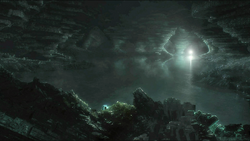
Voldemort then gravitated towards several of his younger recruits who were specially magically powerful and fanatically loyal. He took only Severus Snape and Bellatrix Lestrange under his personal wing, sharing with them his personal-secret knowledge of the Dark Arts; and inspiring in Bellatrix a delusional-psychotic attraction bordering on loving obsession, which Voldemort never returned. He also entrusted his diary Horcrux to Lucius Malfoy, with whom he schemed of using to secretly re-open the Chamber of Secrets, for he did not dare attack Hogwarts directly as long as Dumbledore was Headmaster, but while Malfoy knew that the diary was the possession of his master, others speculated in later years that he knew nothing of its true nature, being misled into believing that the diary was bewitched cleverly to compel another into fulfilling the legacy of Salazar Slytherin by unleashing the slumbering Basilisk for a third time. This did not come to fruition till many years later. Severus Snape, a fellow half-blood with whom he had much in common, quickly became his most valuable servant; even more so than his right-hand Bellatrix Lestrange, though Voldemort never told her that. Snape was also the only Death Eater, who Voldemort allowed to freely act, unless it was a mission of great importance.
Skirmish at the Horcrux cave
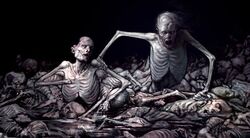
In 1979, Regulus Black, the younger brother Sirius Black, graduated from Hogwarts and joined the Death Eaters. He remained a pure-blood supremacist, but quickly became incredibly disenchanted with the cause's insane and brutal leader and despite his upbringing, the actions being taken out against Muggles left Regulus mortified. Around this time, Voldemort felt the need to test the defences around his Horcruxes. To make sure Slytherin's locket was secure, he requested the use of Regulus's house-elf Kreacher and then callously left him to die. When Kreacher managed survive and to return home, Regulus deduced that Voldemort had created a Horcrux and attempted to destroy it. This failed and resulted in his violent death at the hands of the Inferi, though he did manage to replace the locket with a fake and entrust the real Horcrux to Kreacher.[15]
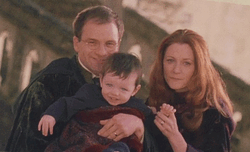
Despite being in the midst of a war, life went on for those who had not yet become its victims. Under the leadership of Dumbledore, Hogwarts remained a bastion of elite-supreme magical education and was left totally untouched by the Death Eaters. It was suggested after the war that marriages and births increased significantly during these years, as the future was uncertain, with the marriage of Arthur Weasley and Molly Prewett being an example of young couples who decided to marry early as a result of the uncertainty of the war.[15] Late in July of 1980, Order members James Potter and Lily Potter had a son, Harry Potter, while Frank Longbottom and Alice Longbottom had Neville Longbottom.
At the same time, Death Eater Lucius Malfoy and Narcissa Black (who, unlike her husband and sister Bellatrix, simply assisted the Dark Lord, rather than became one of his followers) had Draco Malfoy, while Crabbe Snr and Goyle Snr also had sons with their respective wives; and Bellatrix Lestrange married Rodolphus Lestrange, though neither of them actually viewed their marriage as legit, only a means of avoiding ending up with anyone less than a pure-blood. Nott and his wife also bore a son named Theodore, though Mrs Nott eventually passed away from unspecified circumstances, leaving her husband a widow and son with the ability to see Thestrals.
Barty Crouch's edict

In 1980, Minister Minchum was also removed from office due to his failure to end the war and was immediately replaced with Millicent Bagnold.[12] Order member Peter Pettigrew was also secretly initiated as a Death Eater, because of the latter's great fear of Voldemort and the foolish conclusion that nothing could be truly gained by resisting him; and began feeding information on the Order's movements to Voldemort. Members began regarding each other uneasily, and Sirius Black suspected that his friend Remus Lupin, who was frequently undercover among Voldemort's werewolf allies, was a spy.[16] When the entire order gathered for a group photograph in July of 1981, no one suspected the truth.
Shortly afterwards, due to Pettigrew's betrayal, Death Eaters began systematically murdering Order members, and the war entered its most desperate phase. Marlene McKinnon was slaughtered alongside her entire family by Travers, Nott, and Mulciber. Edgar Bones, his wife, and their children were murdered by Thorfinn Rowle and Fenrir Greyback, while Edgar and Amelia Bones's mother and father were both killed by Voldemort himself. Gideon Prewett and Fabian Prewett both fought bravely but were ultimately slain by Antonin Dolohov and four others (losses that deeply affected their younger sister Molly), and Dorcas Meadowes was singled out for murder by Voldemort himself for the threat she posed. Caradoc Dearborn disappeared and was never found, though he was presumed dead, and his body disposed of. Benjy Fenwick was killed by Death Eaters with a powerful curse, exploding him in such a way that only bits of him were recovered.[13]
Witches and wizards of the Order were not the only ones to face attack; many who had aided the war effort against the Death Eaters were marked for execution. Among these brave souls were Mr and Mrs Winger, a married couple who, though they were not members of any defence organisation, still gave those who defied the Death Eaters their full support, providing their services to the freedom fighters and even entering the fight against Voldemort's forces at least once. In answer, the Death Eaters attacked the Winger family's home and slew both of them, though the couple's son Talbott had been trained by his mother to morph into an eagle at will, allowing him to fly away to safety.[17] Peregrine also participated in the seemingly futile fight against the growing enemy forces and in the process, not only were several of his friends thrown ill-prepared (at least in his eyes) into the battle and killed, but his wife was also once nearly captured or killed, to his terror, something that contributed to his eventually conclusion that the Ministry was corrupt.[18] Numerous wizards who made their defiance against the dark forces known were marked out for torture, dozens of which were carried out by Antonin Dolohov, with the aid of Igor Karkaroff.
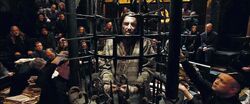
In response to this brutal onslaught, Barty Crouch Snr, who despised Voldemort, the Death Eaters, and the Dark Arts entirely; issued an edict giving Ministry Aurors full permission to fight to kill and employ the use of the Unforgivable Curses against their enemies. A massive Ministry campaign, spearheaded and led by Alastor Moody, Kingsley Shacklebolt, and Frank and Alice Longbottom; ensued, immediately turning the tide of the war against the Death Eaters. They initially focused their efforts on resisting the armies of giants, killing many of them with the Killing Curse, and wiping out entire tribes until they forced the survivors to go into hiding.[13] Finally, the Ministry began to identify and apprehend Death Eaters.
Auror and Order member Alastor Moody became legendary for his successes, arresting and capturing Igor Karkaroff after a six month-long hunt along with many other supporters of the Dark Lord, and also killing Evan Rosier when he resisted arrest, although at the cost of losing a chunk of his nose in the process and gaining himself a vast array of enemies among the families of those he captured. Antonin Dolohov also met his capture and imprisonment at the hands of Magical Law Enforcement Squad and Corban Yaxley, one of Voldemort's earliest followers, was captured and sent to Azkaban as well, though he would eventually worm his way into receiving a general pardon. Still Voldemort himself remained untouchable, both for his elusiveness, and for his legendary power and skill, which no one but Dumbledore could match.
The prophecy and the fall of the Dark Lord
- "The one with the power to vanquish the Dark Lord approaches... born to those who have thrice defied him, born as the seventh month dies... and the Dark Lord will mark him as his equal, but he will have power the Dark Lord knows not... and either must die at the hand of the other for neither can live while the other survives..."
- — The prophecy of Voldemort's fall[src]

During the worst days of the war, in late 1980; James and Lily Potter lived in Godric's Hollow, England with their son, Harry. The family had been asked to go into hiding by Professor Dumbledore himself, as they knew they were definitely on Voldemort's radar as hated enemies. James then lent his family heirloom Invisibility Cloak to Dumbledore, who was curious about its properties. Around this time, Dumbledore met with Sybill Trelawney at the Hog's Head Inn in Hogsmeade regarding the vacant position of Divination teacher. During the interview, Trelawney entered into a magical trance and made a real prophecy: in which she foretold the futuristic coming of a young wizard who would not only become Voldemort's equal; but would finish The Dark Lord for good, due to this individual having strength, power, courage, will, purity of heart, and most of all: a deep love that would not only surpass those of Lord Voldemort, but of Albus Dumbledore himself.
There were two possible candidates, both born in July of 1980 to members of the Order of the Phoenix who had thrice defied the Dark Lord: Harry Potter and Neville Longbottom.[13] Severus Snape was also secretly at the inn, and managed to overhear only part of the prophecy before being discovered and thrown out by the inn's keeper, who was secretly Order member Aberforth Dumbledore, Dumbledore's younger brother. Snape then immediately reported what he had heard to Voldemort, who became so fearful and was greatly concerned over the information. Voldemort then immediately assumed that it meant the Potters' son (a half-blood like himself) and resolved to personally kill the infant at any cost whatsoever. Dumbledore then hired Trelawney so that she would be safe from Voldemort and his Death Eaters.
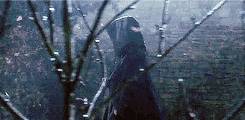
Complicating Voldemort's plan, Snape secretly harboured a deep everlasting love for Lily Potter, since the two had been friends since childhood; so great enough that he covertly defected to the Order of the Phoenix after he secretly told Dumbledore that Voldemort had marked her and her family for death, begging the legendary wizard to hide and protect the family from Voldemort at all costs.[15] Dumbledore agreed, and urgently bade the Potters to go into hiding under the protection of the Fidelius Charm. While James and Lily wanted Sirius Black to be their Secret-Keeper, because he was their closest and most trusted friend, and the fact the Sirius had been made Harry's godfather; it was for exactly those reasons that Black claimed that he was too obvious a choice and that Voldemort would suspect him.
Instead, he suggested Peter Pettigrew, an ordinary wizard who no one would ever expect. Thus, the real traitor became the Potters' Secret-Keeper, though no one (not even Dumbledore or Lupin) knew of the switch, and within a week Pettigrew told his master Voldemort the Potters' location, officially breaking the Fidelius Charm and leaving the Potters completely vulnerable.[16] Meanwhile, Dumbledore discovered that James's Invisibility Cloak was in fact the Cloak of Invisibility, the third of the legendary Deathly Hallows.

On 31 October 1981, Voldemort travelled to the Potters residence in Godric's Hollow. He then casually and secretly entered their house, and instantly and swiftly murdered James with the Killing Curse, who was unarmed, but he offered Lily a chance to save herself if she stepped away from the crib containing her infant son. Voldemort wished to honour Snape's request to spare Lily, but Lily refused and when Voldemort became agitated and angry, he gave her one last warning to move aside. Lily still refused, thus, Voldemort murdered her as well with the Killing Curse. He then turned his wand on Harry.
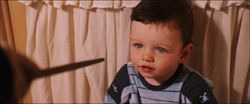
However, Lily's loving sacrifice gave Harry an ancient and unbelievably powerful magical protection (an ancient counter-charm rooted in the power of love); and when Voldemort attempted to kill Harry with the Killing Curse, the curse rebounded and was deflected upon Voldemort himself. It was in that very moment, that Voldemort unknowingly made Harry himself his seventh and final Horcrux. However, it did not come without serious cost. The Killing Curse caused Voldemort's physical body to be destroyed and his power was completely broken and zapped from him. In addition, the curse left Harry with only a lightning-shaped scar on his forehead, and also secretly transferred an array of Voldemort's own power and magical skills to Harry: caused when the fragment of Voldemort's already mangled and shattered soul entered Harry and turned him into a Horcrux.
The Boy Who Lived
- "To Harry Potter — the boy who lived!"
- — Celebrations going on at the end of the war and the destiny forced upon the young Harry Potter[src]

Although Voldemort's body and magic were destroyed, he did not die because of his Horcruxes enabling him to survive; albeit in a bodiless, powerless spectral form. In utter fear and desperation, he immediately fled the collapsing house and the country entirely, unwilling to be seen by anyone in such a weakened and desperate state, not even his own Death Eaters. Only one ability remained to Voldemort: he could still possess the bodies of other living beings.
Order member and Hogwarts groundskeeper Rubeus Hagrid arrived on the scene about an hour after Voldemort fled; secretly acting on Dumbledore's orders to rescue Harry from the cottage ruins with unexpected help from Sirius Black, who instantly became aware of Pettigrew's treachery after finding his house empty with little sign of a struggle. Black then tried to convince Hagrid to give him Harry (since had been named the boy's legal guardian in the event of James and Lily's deaths), but Hagrid told him that Dumbledore had ordered Hagrid to bring Harry directly to him at an undisclosed location, so Black lent the half-giant wizard his flying motorbike to carry the baby on for the journey to meet with Dumbledore.
That same night, news of Voldemort's downfall and apparent death spread like wildfire throughout all of Great Britain; with monumental celebrations breaking out all across the country so strenuously that numerous large-scale breaches of the International Statute of Wizarding Secrecy were noticed by the Muggle international media. This was excused by Minister Bagnold, who asserted the war-weary wizarding community's "inalienable right to party". Though some people, like Barty Crouch Snr, claimed the celebrating got out of hand and became childish and ridiculous.

Touted as the "Boy Who Lived", Harry Potter's status as the being who defeated the most powerful dark wizard who ever lived, the first and only person ever to survive the Killing Curse and the reason for the end of the war lead to him becoming a world famous household name and celebrity overnight. However, he was also an orphan, so Hagrid took him to the town of Little Whinging, Surrey. Dumbledore and Order member Minerva McGonagall were both waiting.
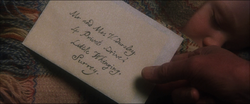
They then left Harry at the doorstep of 4 Privet Drive, the residence of his maternal aunt Petunia Dursley and her husband Vernon Dursley, whom were muggles and despised magic. Dumbledore left a note with him explaining the circumstances to the Dursleys, most importantly that they must allow Harry to grow up in their home and return there once a year in order to ensure that his mother's protection would continue working, as he knew that Voldemort would someday return and that Harry would be in danger. Order member Arabella Figg, who was a Squib and also lived a few houses down, accepted the task of secretly keeping watch over Harry and the Dursleys.
Decline of the Death Eaters
- "The Dark Lord will rise again, Crouch! Throw us into Azkaban; we will wait!"
- — Bellatrix Lestrange's parting words at her trial[src]
In the aftermath of Voldemort's shocking defeat and subsequent disappearance without a trace, many were sceptical that he was really dead, believing that he was too powerful or simply too inhuman to die like a normal wizard. Aurors, Order members, and Ministry officials alike searched at home and abroad for any sign of him but found none. Although they eventually came to the conclusion that Voldemort had truly been defeated and was dead, many Death Eaters were still at large and considered a threat.
Having secretly retrieved his master's wand from the destroyed Potter residence, Peter Pettigrew attempted to go into hiding with it the next day in fear of being perceived a traitor by the Death Eaters (since his information inadvertently caused Voldemort's downfall), but was confronted by Sirius Black on a street in London, England full of Muggles. In order to escape, he used Voldemort's wand to conjure a powerful Blasting Curse that killed twelve Muggle bystanders and transformed into his Animagus form of a rat, leaving behind a severed index finger as fake evidence against his opponent. This left Black universally perceived as the traitor to the Potters, as well as a mass murderer, for which he was quickly arrested and carted off to Azkaban without a trial, whereas Pettigrew was universally thought to be dead and unjustly awarded the Order of Merlin (First Class) for his supposed willingness to stand up for the safety of a friend.[16]
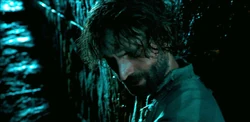
In addition, other Death Eaters like Travers, Mulciber, and three others who helped murder the Bones family, were likewise captured and imprisoned, while Dumbledore gave personal testimony exonerating Severus Snape, who he also hired as the Potions Master at Hogwarts to replace the retiring Horace Slughorn. Fenrir Greyback and other werewolves went back underground, and the few remaining Giants left the British Isles entirely and resettled in the last remaining Giant colony in the world in rural Denmark.[13]

Mr and Mrs Snyde, who had both been responsible for numerous injuries and deaths among the Aurors, both stood before a court for their crimes at a trial witnessed by their daughter Merula and both were sentenced to Azkaban. Their imprisonment had a highly damaging and traumatising effect on all of the family, especially Merula, who adopted a cold attitude towards most people after this and grew to strongly believe in the importance of loyalty to family, rendering her susceptible to the manipulations of her aunt Verucca in later years. The remaining Snydes would also receive a constant flow of hate mail from victims of Merula's parents and their families, who threatened in their notes to take vengeance on Merula, something that led to adults isolating themselves from Merula. Barnaby Lee's mother and father would also end up in Azkaban, and Virgil Fowler's parents were killed either during or shortly after the war.
However, Igor Karkaroff gave up Augustus Rookwood, who was thrown into Azkaban, in exchange for his freedom, which he used as an opportunity to flee the country and eventually gain employment as the new Headmaster of Durmstrang Institute Of Magic in Eastern Europe. The subsequent investigation of Rookwood's spy network led to numerous individuals being questioned (including Ludovic "Ludo" Bagman, Beater for the Wimbourne Wasps, who was found not guilty).[14] Despite the Ministry crackdown, spearheaded by Barty Crouch Snr, Albus Dumbledore, and Alastor Moody; some Death Eaters were able to walk free [such as the Malfoy Family, who claimed to have been under the Imperius Curse and were cleared]. Many innocent people were released from the Imperius Curse indeed, following Voldemort's defeat, so some of them used this as an excuse. Others simply used their wealth, power, and influence to avoid punishment for their crimes.
Lucius Malfoy, Nott, Avery, the Carrow siblings, Crabbe, Goyle, and Corban Yaxley were brought to face justice, but were officially considered innocent in the years after the war, while Thorfinn Rowle, Gibbon, Selwyn, Jugson, were all convicted and sent to Azkaban.[citation needed] Assuming that Voldemort was dead and gone, those who were cleared simply carried on with their daily lives as if nothing had ever happened, though it was nevertheless hoped by many who had escaped conviction that the Death Eaters could perhaps one day find for themselves a new master to serve in the form of their previous one's downfall: Harry Potter, who some of Voldemort's old followers hoped could prove a future champion of pure-blood supremacy that they could again rally behind.
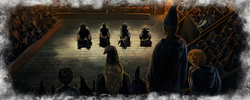
However, not all Death Eaters were content to give up Voldemort's cause. Having managed to "talk their way out" of a sentence in Azkaban, Bellatrix Lestrange, Rodolphus Lestrange, and Rabastan Lestrange, along with Crouch Snr's own son, Bartemius "Barty" Crouch Jnr, abducted and interrogated Frank and Alice Longbottom. Believing that they had information on Voldemort's whereabouts, they tortured them at once with the Cruciatus Curse so severely that they were left mentally insane with no possibility of returning to their former state. However, even the entire Lestrange family and Crouch Jnr were ultimately captured and arrested by a convoy of Aurors led by Alastor Moody and Kingsley Shacklebolt.
The Longbottoms were moved to St Mungo's Hospital for Magical Maladies and Injuries in Diagon Alley for long-term care and their infant son, Neville Longbottom, was left to be raised by his grandmother Augusta Longbottom. The horrific attack against the well-liked family enraged the magical public so much and was considered one of the most dreadful crimes ever recorded. Barty Crouch Snr, disgusted and shame-ridden that his own son was a Death Eater, sentenced them all to life in Azkaban within mere minutes of the court proceedings, to the roared approval of all present at the trial, who savagely applauded the motion. Bellatrix then proudly proclaimed her loyalty and declared that the Dark Lord would return to liberate her and her family as they were dragged away by a horde of Dementors, confident that their faith would see them richly rewarded by their master after his return.[14]
Aftermath
Now stripped of almost all magical abilities, Voldemort eventually made his way to Albania, where he started haunting the remote forest he visited years earlier. There, he tried to gain physical form by briefly possessing the bodies of various animals, his preference being snakes, which only reduced their lifespan due to them being ill-equipped to perform magic. Any help he possibly had in order to potentially render himself mostly required the use of a wand, yet it was too dangerous for Voldemort to enter the outside world and possess humans, for he was aware that the Aurors were still abroad in search for any sign of him. So he waited, desperately hoping that one of his faithful followers would find him and restore him to power, unaware that most of those that were truly faithful to him were either imprisoned or dead.

Having hidden Voldemort's wand to prevent it from falling into Ministry hands, Pettigrew scurried all the way to Devon, where he was taken in by the blood-traitorous Weasley family through their third oldest son Percy Weasley as a pet named "Scabbers". This enabled the rat to stay aware of magical current events until hearing any rumour of the Dark Lord rebuilding his power, which would thus make it safe for Pettigrew to return to him. It was made clear to the Weasleys that Scabbers was very extraordinary since all rats of his species had a life expectancy of three years, they continued owning him for much longer up to the point where he was inherited by their youngest son Ron Weasley. When Ron would later become best friends with Harry Potter at Hogwarts, Pettigrew saw his opportunity to capture and deliver the Boy Who Lived to Voldemort as a welcome-back gift, as well as dissuading his fellow Death Eaters from ever daring to claim him a traitor. But he never took action in doing so immediately without certain assurances, for he knew Voldemort was not strong enough to protect him at that point.
At his dying wife's request, Bartemius Crouch Snr orchestrated the first assisted escape from Azkaban to save his son from a life imprisonment. He accomplished this by having mother and son switch appearances via Polyjuice Potion, at which point he left with his son while his wife stayed behind. Crouch used the Imperius Curse and an Invisibility Cloak to imprison his son in their home under the constant care of his house-elf Winky. After his "son" died in Azkaban, he also faked the death of his wife to uphold the deception. With the war over, the public began to re-examine Crouch's relationship with his son, and his reputation took a major hit. Whereas it had been anticipated that he would replace Millicent Bagnold as Minister for Magic, his meteoric political career was effectively ended, and he was demoted to Head of the Department of International Magical Co-operation. His son, meanwhile, grew increasingly insane and fanatical the longer he was imprisoned.

Despite the victory and ensuing peace, the War implanted doubt in the hearts of some of the wizarding community about the competence of the Ministry of Magic and an enigmatic, illicit secret society of wizards known simply as R came to eventually regard the Ministry as corrupt to the core, feeling that its inability to incarcerate rich and powerful individuals like Lucius Malfoy for their Death Eater activities signified that the wizarding government could no longer be trusted with the safety of the community. R would eventually fall under the leadership of Peregrine, who had lost numerous friends of his in service to the Ministry during the War and had subsequently grown to regard the Ministry with a prejudice that mirrored that of R. Under Peregrine, R sought to purge the Ministry of Magic of its 'corrupt' members with the powers of the Crown of Mneme, and with Peregrine as their leader and Verucca Buckthorn-Snyde his 'Director', R led a series of clandestine operations across the world to achieve their goal, including an attempt to find the legendary Cursed Vaults. The doubt was not unique to R, however, and though they did not subscribe to the same fanatical beliefs, there were even those in the Ministry itself who wondered if the Ministry was in a position of trustworthiness, with several of its employees, such as Arthur Weasley and Auror Office personnel Mrs and Mr Karasu, believing that there were those among their co-workers who once lived the lives of Death Eaters.
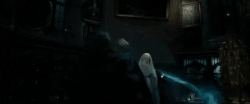
With dark forces having terrorised the wizarding communities of Great Britain for over a decade, claimed thousands of victims, and scarred, bereaved, and traumatised countless others, the survivors of the war began to rebuild. The spectre of Lord Voldemort, who had supplanted Grindelwald as the most powerful and dangerous Dark wizard of all time, still held a terrible influence, as the widespread fear of the sound of his name continued even over a decade after his downfall. The horrifying idea that he had not truly been defeated lingered, with some thinking he was dead, others thinking he was just waiting for the right moment to resurface, and the majority thinking that he was still alive, but "horribly weakened" and "half-dead". Whatever opinion they subscribed to, the majority of the wizarding world collectively felt terror at the mere mention of the dark name, referring to Voldemort by the titles of 'You-Know-Who' or 'He-Who-Must-Not-Be-Named' whenever possible.
However, Albus Dumbledore and his supporters from the now disbanded Order of the Phoenix knew that Voldemort would return. As a precaution, he contacted his friend Nicolas Flamel, who agreed to lock up the Philosopher's Stone, one of the few methods by which Voldemort could regain his power, in a Gringotts vault.[5] Severus Snape vowed that he would protect Harry Potter at all costs, as the boy was destined to defeat the Dark Lord once and for all.[15]
Behind the scenes
- Since both this conflict and the Second Wizarding War took place mainly in Britain and other parts of the United Kingdoms, mainly between the official government and an insurgent movement, then both these conflicts could be classified as civil wars.
- While called the First Wizarding War, there have been previous magical conflicts, such as Gellert Grindelwald's revolution, that occurred before Voldemort ever came into power and on a grander scale and was more akin to a World War.
Media
Appearances
- Harry Potter and the Philosopher's Stone (First appearance)
- Harry Potter and the Philosopher's Stone (film)
- Harry Potter and the Philosopher's Stone (video game)
- Harry Potter and the Chamber of Secrets (Indirectly mentioned only)
- Harry Potter and the Prisoner of Azkaban (Indirectly mentioned only)
- Harry Potter and the Goblet of Fire (Appears in flashback(s))
- Harry Potter and the Goblet of Fire (film) (Appears in flashback(s))
- Harry Potter and the Order of the Phoenix (Appears in flashback(s))
- Harry Potter and the Order of the Phoenix (film) (Mentioned only)
- Harry Potter and the Order of the Phoenix (video game) (Mentioned only)
- Harry Potter and the Half-Blood Prince (Indirectly mentioned only)
- Harry Potter and the Deathly Hallows (Appears in flashback(s))
- Harry Potter and the Deathly Hallows: Part 1 (Appears in flashback(s))
- Harry Potter and the Deathly Hallows: Part 2 (Appears in flashback(s))
- Harry Potter and the Cursed Child
- Harry Potter and the Cursed Child (play)
- The Tales of Beedle the Bard (Indirectly mentioned only)
- LEGO Harry Potter: Years 1-4
- LEGO Harry Potter: Years 5-7 (Appears in flashback(s))
- Pottermore
- Harry Potter (website)
- Harry Potter prequel
- Harry Potter: Hogwarts Mystery (Mentioned only)
- Harry Potter: Wizards Unite (Mentioned only)
- Harry Potter: Magic Awakened (Appears in the spell book)
Notes and references
- ↑ Pottermore - From the Story: Evan Rosier
- ↑ Harry Potter and the Half-Blood Prince, Chapter 17 (A Sluggish Memory)
- ↑ Harry Potter and the Chamber of Secrets
- ↑ 4.0 4.1 Harry Potter and the Half-Blood Prince
- ↑ 5.0 5.1 Harry Potter and the Philosopher's Stone
- ↑ Harry Potter and the Prisoner of Azkaban, Chapter 18 (Moony, Wormtail, Padfoot and Prongs)>Hepzibah died ten years before Voldemort met with Dumbledore. Lupi, born 1960, was bitten near his fifth birthday in 1965 and his quote in PoA tell us Dumbledore became Headmaster after this, between 1965 and 1971, meaning Hepzibah died between 1955 and 1961
- ↑ Bloomsbury Live Chat
- ↑ Fantastic Beasts and Where to Find Them
- ↑ Writing by J. K. Rowling: "Remus Lupin" at Harry Potter (website)
- ↑ Harry Potter and the Prisoner of Azkaban, Chapter 18 (Moony, Wormtail, Padfoot and Prongs) - Remus Lupin says "I was a very small boy when I received the bite...But then Dumbledore became Headmaster, and he was sympathetic." According to Writing by J. K. Rowling: "Remus Lupin" at Harry Potter (website), Remus Lupin became a werewolf shortly before he turned 5 in March 1965 and Dumbledore visited him as Headmaster shortly before his eleventh birthday. This means Dumbledore became Headmaster between March 1965 and March 1971.
- ↑ Writing by J. K. Rowling: "The Malfoy Family" at Harry Potter (website)
- ↑ 12.0 12.1 12.2 Writing by J. K. Rowling: "Ministers for Magic" at Harry Potter (website)
- ↑ 13.0 13.1 13.2 13.3 13.4 Harry Potter and the Order of the Phoenix
- ↑ 14.0 14.1 14.2 Harry Potter and the Goblet of Fire
- ↑ 15.0 15.1 15.2 15.3 Harry Potter and the Deathly Hallows
- ↑ 16.0 16.1 16.2 Harry Potter and the Prisoner of Azkaban
- ↑ Harry Potter: Hogwarts Mystery, Year 3, "Become an Animagus" Achievement - Part 3, Side Quest "Animagus Lessons" (info only revealed should the player choose to participate this time-limited Side Quest, and reach a specific stage before the task ended.)
- ↑ Harry Potter: Hogwarts Mystery, Year 7, Chapter 48 (Archival Evidence)

